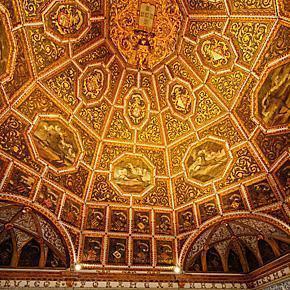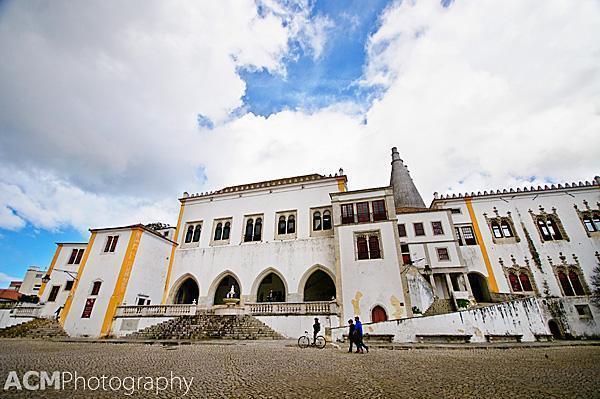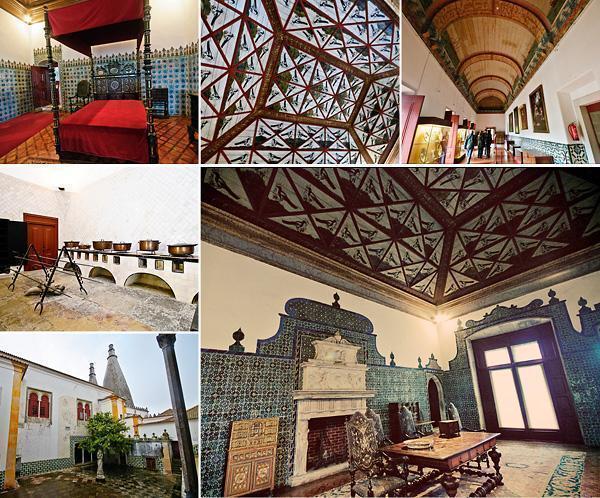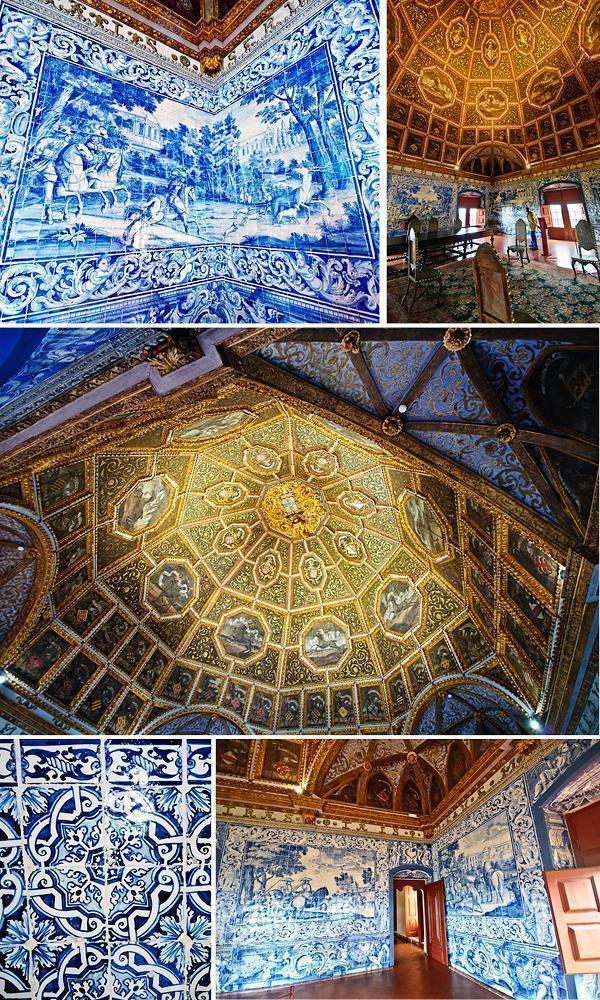
The incredible coat of arms ceiling of the Blason’s Hall, Sintra National Palace, Portugal
With its brightly painted tile walls and elaborate mural ceilings, the Sintra National Palace, is well worth exploring on a day-trip from Lisbon, Portugal.
One of the most fascinating and beautiful places we visited on our recent trip to Portugal and Spain, was the town of Sintra, not far from the capitol, Lisbon.
Sintra, nestled in the mountains, was a playground for the rich and famous of Portugal from the 15th to the 19th centuries. The wealthy tried to outdo each other with their elaborate estates, castles and gardens. Many of them are now restored and open to the public.
Sintra was designated a UNESCO World Heritage site in 1995 and is a Mecca for day-trippers from Lisbon. Tour buses chug up the narrow mountain roads and visitors parade through the town.
We decided to spend the night in Sintra and see what the fuss was about. During our stay, we visited 3 palaces: the Sintra National Palace, the Pena National Palace, and the Monserrate Estate. Today we’ll explore the first of these incredible buildings, the Sintra National Palace.

The facade of The Sintra National Palace with the 33 metre chimneys visible in the back.
The Sintra National Palace is located in the town centre. Although there is evidence a palace existed on the site in the 10th century, the current Sintra National Palace is a mixture of Gothic, Manueline and Moorish styles from the 15th and early 16th centuries. The stark white palace is less ornate than many of the other palaces and estates nearby and is dominated by two enormous chimneys rising 33 metres over the kitchen.
The design and decoration of the palace’s interior was sponsored by King Manuel I with wealth acquired during the Age of the Discoveries. He ordered unique hand-crafted tiles from Seville to decorate the walls of most of the rooms and had many of the ceilings painted with elaborate frescoes.

Clockwise from the top: Tiled walls in one of the many bedrooms; the Magpie ceiling; The Galleon Room; The Magpie Room; The patio and chimneys; The kitchen
The most elaborate and breath-taking room in the Sintra National Place is the Sala dos Brasões, the coats of arms room or Blazons Hall. This room is decorated in striking blue and white tiles, or Portuguese Azulejos , depicting hunting scenes. The domed ceiling is decorated with the coats of arms of 72 Portuguese royal families.

The incredible ceiling and tiles of the Sala dos Brasões or Blasons Hall
Other impressive rooms include the Magpies Hall, the Swans Hall, the Arab Room and the Palatine Chapel. It’s hard to walk around the Sintra National Palace without getting a crick in your neck from staring at the incredible ceilings.

Clockwise from top: The exterior; The Swan Room; The chapel; A touch of Asia; Manueline Hall; Door in the Arab Room
Outside the main entrance of the palace, you can see the colourful houses of the town of Sintra, presided over by the ruin of the Castelo dos Mouros, or Castle of the Moors, on the mountaintop above.

View of Sintra and the Castle of the Moors, from the National Palace
Stay tuned as we explore two more beautiful palaces of Sintra, Portugal in upcoming posts.
Palácio Nacional de Sintra
Largo Rainha Dona Amélia
2710-616 Sintra
Love castles, palaces, and ruins like in this article? Us too! Don’t miss the full listing of Castles we’ve visited in Europe and beyond.
- The Ultimate List of Castle Hotels in Belgium - June 10, 2019
- The Ultimate Guide to the Best Things to Do in Normandy, France - February 5, 2019
- The Ultimate Guide to the Best Restaurants in Brussels, Belgium - January 11, 2019
- A Tale of Two Towers in Belém, Lisbon, Portugal
- Jerónimos Monastery, Lisbon, Portugal, in Photos
- Azulejos – The Colourful Tiles of Lisbon
- Visiting the Castle of São Jorge – Lisbon, Portugal
- Lisbon, Portugal – Our 10 Favourite Photos
- Visiting the Sintra National Palace in Portugal
- Visiting Pena National Palace, Sintra, Portugal
- Visiting Monserrate Palace and Gardens, Sintra, Portugal
- Zahara de la Sierra and the Pueblos Blancos of Andalusia, Spain
- Ronda, Spain – Canyons, Cliffs and Bullrings in Andalusia
- Visiting Gibralfaro Castle and the Alcazaba of Malaga, Spain
- Gibraltar is Weird and We Like it that Way
- The Alhambra and Generalife of Granada, Spain in Photos
- Visiting The Cathedral–Mosque of Córdoba, Spain
- Our Favourite Photos from Granada and Cordoba, Spain
- Visiting the Alcázar of Seville, Spain
- Visiting Seville Cathedral and the Giralda, Andalusia, Spain
- Our 10 Favourite Photos from Seville, Spain
- Our Favourite Photos of Architecture in Prague, Czech Republic
- The Weekend London Tried to Kill Me
- Exploring the Tropical Rainforest of the Eden Project, Cornwall, England
- Otters and Butterflies in Dartmoor, England
- Our Favourite Photos of England
